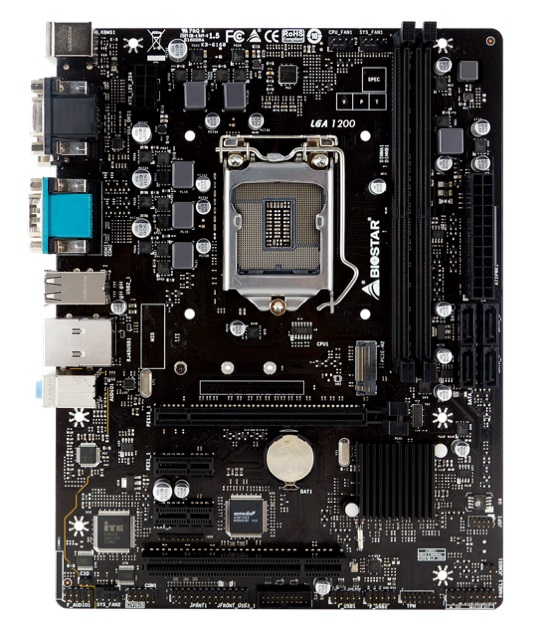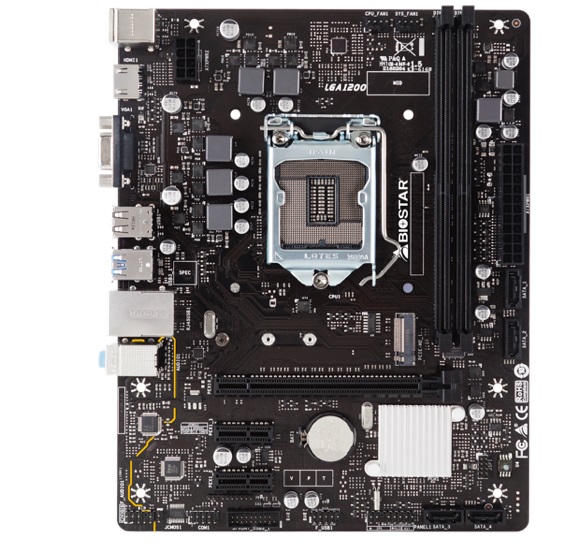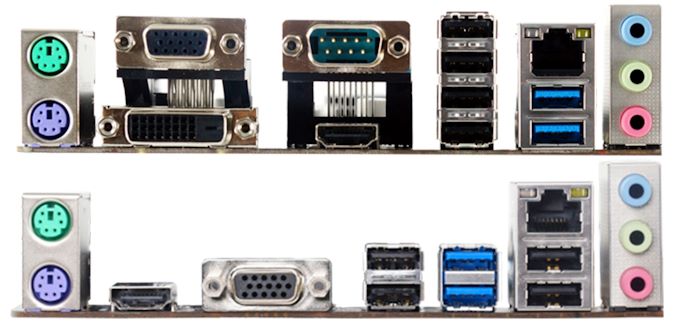Biostar's Two New H410 Motherboards: H410MHG and H410MH
by Gavin Bonshor on May 29, 2020 1:00 PM EST
Not only did Intel unveil its Z490 motherboard chipset for Intel's 10th generation desktop processors, but it also announced its more budget-friendly chipsets. Biostar has announced two new micro-ATX H410 models, the H410MHG, and the H410MH, aimed at the low cost and high volume market. Both with simplistic designs and budget-friendly controller sets, both models include Realtek Gigabit networking, Realtek ALC887 HD audio codecs, as well as four SATA ports and a single PCIe 3.0 x4 M.2 slot.

Biostar H410MHG micro-ATX motherboard
Starting with the higher-specification of the two new H410 models from Biostar, the H410MHG includes TPM technology which adds hardware-based security functionality designed for cryptographic operations. In regards to PCIe, it consists of a single full-length PCIe 3.0 x16 slot, two PCIe 3.0 x1 slots, and a single PCI slot. There are four straight-angled SATA ports below the 24-pin 12 V ATX motherboard power input, while a single 8-pin 12 V ATX input provides power to the CPU. On the rear panel is two USB 3.2 G1 Type-A, and four USB 2.0 ports, with an HDMI, DVI-D and VGA port allowing users to use Intel's integrated UHD graphics. A COM port, a PS/2 mouse and PS/2 keyboard port are also present for users looking to use legacy peripherals. For cooling, the H410MHG also has three 4-pin fan headers, one for a CPU fan, and two for chassis fans.

Biostar H410MH micro-ATX motherboard
The Biostar H410MH has a single full-length PCIe 3.0 x16 slot, and two PCIe 3.0 x1 slots, with four SATA straight-angled SATA ports, and offers a slightly lighter rear IO panel. It includes separate PS/2 keyboard and mouse ports, two USB 3.2 G1 Type-A, four USB 2.0 ports, and two video outputs consisting of HDMI and VGA. For the cooling, it has just two 4-pin headers with one dedicated for a CPU fan, and the other for a chassis fan.

Biostar H410MHG (top) and H410MH (bottom) rear panels
Shared across both models includes the memory and networking support, with a Realtek RTL811H Gigabit Ethernet controller, and two memory slots with support for up to 64 GB of DDR4-2933 memory. The H410MHG and H410MH also feature a Realtek ALC887 HD audio codec which provides three 3.5 mm audio jacks on the rear panel, as well as a single PCIe 3.0 x4 M.2 slot with support for both NVMe and SATA drives.
Although Biostar hasn't announced pricing or availability for the H410MHG and H410MH models, likely, they won't be too expensive. Designed more for cost-focused users looking for a foundation while leveraging the power of Intel's 10th generation processors, both of these micro-ATX H410 models include access to the Biostar VIP Care portal for additional support from Biostar.










24 Comments
View All Comments
DanNeely - Friday, May 29, 2020 - link
I'm surprised legacy PCI hasn't moved from mass market boards to specialty legacy compatibility models yet.Flunk - Friday, May 29, 2020 - link
It's particularly strange because modern chipsets don't even support PCI. They need to put an additional controller on the board to support it.DanNeely - Friday, May 29, 2020 - link
bridge chips are cheap. When PCIe first came out they only added a few dollars to the retail price and served to allow quick and dirty ports of lots of basic cards. Today the R&D is long paid for; so they should be even cheaper.BedfordTim - Friday, May 29, 2020 - link
BioStar may also be targeting the industrial market where there are still a lot of old cards people need support for.Samus - Saturday, May 30, 2020 - link
^^^Thisesoel_ - Saturday, May 30, 2020 - link
Yeah that board has a serial port too.DanNeely - Monday, June 1, 2020 - link
AFAIK The serial port is powered by the same SuperIO chip that powers the PS2 ports; making it less of a big deal because the controller is already onboard. Fun fact, the same chip also offers support for a parrallel port and floppy controller, and got its name because in the 90s combining all the stuff it did into a single chip instead of several addon cards was a big deal.brucethemoose - Friday, May 29, 2020 - link
I still have a PCI Xonar ST. And TBH, the first feature I'll look for on a Zen 3 or Sunny/Willow cove board is PCI.But thats a heck of a niche use case. IDK what everyone else is using those PCI slots for, as audio is just about the only thing that ages well.
Operandi - Friday, May 29, 2020 - link
Audio should be external to the PC.The only real use for legacy interfaces is for legacy hardware that can't be replaced, so weird industry specific shit.
Scalarscience - Friday, May 29, 2020 - link
weird industry specific shit = audioI have 3 RME interfaces over time here 2 of which are PCIe and one is PCI. For outboard they now have TB/USB3, previous was FW/USB2 or PCIe. But I still have a PCI based HDSP+Multiface I breakout box which matches the 2 PCIe HDSPe+Multiface II boxes I have as well. Similarly I have Korg and Scope DSP interfaces, and the Scope ones still rock but need a 100% solid PCI implementation.
Certainly not needed on a Gamer board and HTPC is an iffy market for PCI as well, but I suppose there might be some thought that an HTPC focused board might also get grabbed up by someone that is using PCI for other 'weird industry specific shit' like olderl ribbon/thermal printers or etc.